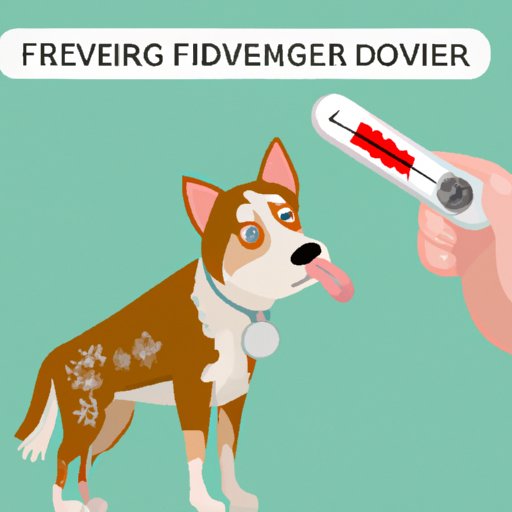
I. Introduction
If you’re a dog owner, you know that keeping your furry friend healthy is a top priority. One way to ensure your dog’s wellbeing is to monitor their body temperature. Dogs, like humans, can get a fever, and detecting this early can help prevent serious health problems. In this article, we’ll explore how you can tell if your dog has a fever, steps to take when you suspect a fever, and how to lower your dog’s body temperature.
II. Signs and Symptoms of a Fever in Dogs
A fever is the body’s way of responding to an infection or illness. In dogs, a normal body temperature ranges from 99.5 to 102.5°F. When your dog’s body temperature rises above this range, it may be a sign of a fever. Some common signs and symptoms of fever in dogs include:
- Lethargy and decreased activity level
- Decreased appetite and water intake
- Shivering or trembling
- Coughing or sneezing
- Increased heart rate and breathing
- Nasal discharge or vomiting
It’s important to note that these symptoms may differ for certain breeds or sizes of dogs. For example, small dogs may show symptoms of a fever more quickly than larger dogs.
III. Steps to Take When You Suspect Your Dog Has a Fever
If you’re concerned that your dog may have a fever, there are some steps you can take to evaluate their condition. First, you can try to assess your dog’s body temperature without using a thermometer. Place your hand on your dog’s stomach or under their armpit to feel for warmth. If your dog feels much warmer than usual, it may be a sign of a fever. However, it’s important to confirm this with a thermometer test.
When taking your dog’s temperature with a thermometer, be sure to use a lubricated rectal thermometer. This may be uncomfortable for your dog, so it’s important to make the process as stress-free as possible. If you’re unsure how to do this, it’s best to consult your veterinarian for advice.
If you determine that your dog has a fever, it’s important to isolate them from other pets or people to prevent the spread of infection.
IV. How to Properly Take Your Dog’s Temperature
When taking your dog’s temperature, it’s important to follow these steps to ensure accuracy:
- Use a thermometer specifically designed for dogs
- Lubricate the thermometer with petroleum jelly or water-based lubricant
- Insert the thermometer gently into your dog’s rectum about an inch or so
- Hold the thermometer in place until it beeps or for about a minute
- Remove the thermometer and clean it with alcohol or soap and water
There are different types of thermometers available for dogs, including digital, glass, and ear thermometers. Digital thermometers are the most accurate and easiest to use. Ear thermometers are an option but can be less reliable. Glass thermometers are not recommended due to the risk of breaking and potentially harming your dog.
V. The Importance of Monitoring Your Dog’s Behavior and Appetite
Monitoring your dog’s behavior and appetite is essential in determining whether their condition is improving or worsening. It’s important to keep track of their water intake, any changes in appetite, and their activity level. If your dog shows signs of dehydration, such as dry gums or lethargy, it may be time to seek veterinary attention.
It’s also essential to note any changes in your dog’s behavior, such as increased aggression or anxiety. These can be signs of pain or discomfort, and may indicate a more serious problem.
VI. When to Call the Veterinarian if Your Dog Has a Fever
A fever can be indicative of a serious health problem, so it’s best to call your veterinarian if your dog’s temperature is above 103°F or if they show any signs of distress or discomfort. Additionally, any fever lasting more than 24-48 hours warrants a call to your veterinarian. Be sure to provide your veterinarian with any information regarding your dog’s symptoms and condition, as this can help in diagnosis and treatment.
It’s best to seek veterinary attention early rather than wait until the condition worsens. A fever can be a sign of a serious infection or other illness, and prompt treatment can prevent further complications.
VII. Home Remedies to Help Lower Your Dog’s Body Temperature
There are some home remedies you can use to help lower your dog’s body temperature, but it’s important to use caution and only use methods that are backed by science. Some safe and effective methods include:
- Give your dog a lukewarm bath or place a cool wet towel over their body
- Use a cooling pad or bed
- Increase your dog’s water intake to prevent dehydration
It’s best to avoid using alcohol or ice packs to lower your dog’s body temperature, as these can be harmful and lead to further complications.
VIII. Preventative Measures to Avoid Fever in Dogs
Preventing fever in your dog starts with regular veterinary check-ups and preventative care. Make sure your dog is up-to-date on all vaccinations and parasite preventatives, and keep them away from other sick animals. It’s also important to protect your dog from extreme temperatures, whether hot or cold, as this can lead to heatstroke or hypothermia. When exercising your dog, be sure to provide plenty of water and take frequent breaks in a shaded area.
IX. Conclusion
Knowing how to tell if your dog has a fever is important in maintaining their overall health and wellbeing. By monitoring your dog’s behavior, taking their temperature when necessary, and seeking veterinary attention when needed, you can help prevent serious health problems. Remember to use caution when trying home remedies and to practice preventative care to keep your dog healthy and happy.





